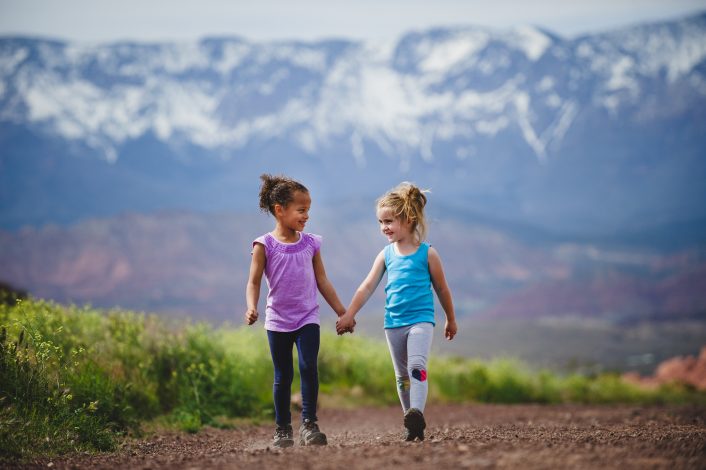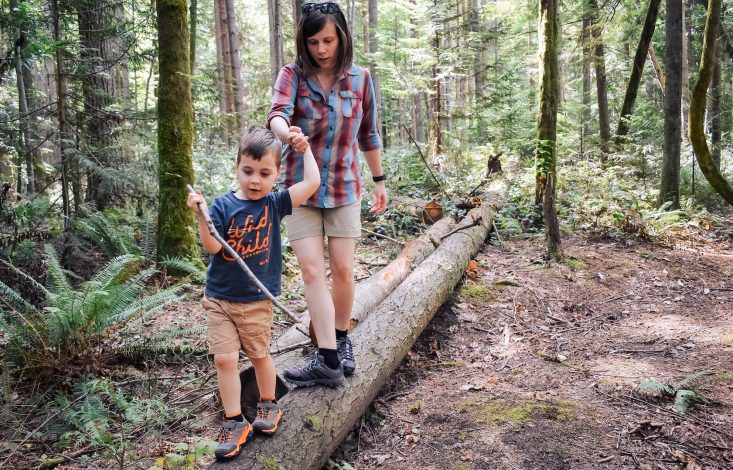Hiking Essentials - What to Wear When Hiking
In the previous two installments of our “Hiking Essentials” series, we discussed what to bring with you on a day hike, along with tips for staying safe on the trail. In this third installment, we're going to talk about what to wear on a hike. Below, I discuss what to wear when hiking, along with some tips based on which season you are hiking in.
Photo by Jessica Human.
Important Factors When Choosing Hiking Clothing
While looking good on the trail is a bonus, there are factors to consider before you buy that adorable (yet not so functional) jacket or shirt for the trail:
1. Your safety: Clothing safety will depend largely on the environment you're hiking in, along with the possible weather conditions. For example, if you're hiking in an area with a Lyme disease outbreak, it may be best to be cautious and wear long pants and long sleeves that are treated with insect repellent, even in the summer months. In addition, if you'll be hiking in rain, a windproof rain jacket is important since wind and rain tend to go hand-in-hand.
2. Your comfort level: There is a reason the term “cotton is rotten” exists in the hiking world. Sweating is our body’s way of regulating our temperature during exercise. Cotton retains water and keeps the sweat in toward your body, which can keep you hot in warm temperatures and chill in cold temperatures. Instead, wicking materials that move sweat away from the body, such as merino wool, polyester and nylon, can keep you much more comfortable throughout your hike. In addition to material, the fit of the clothing is important. When I started hiking, I made the mistake of trying to look good on a hike and selecting clothing that was more fitted and tight. Unfortunately, that also meant that I had a more limited range of motion, making hiking in these clothes a rather miserable experience. Choosing a roomier fit provides more flexibility and comfort while hiking. Let’s face it, nobody looks good on a hike when they are uncomfortable and miserable!
3. Clothing versatility: Quality gear can come with a hefty price tag, so keep in mind clothing that can be used for multiple purposes. Two articles of clothing that come to mind are a) lightweight hiking shirts with long sleeves that can be rolled up and secured, and b) convertible pants with pant legs that zip off into shorts.
The Basics
1. Underwear: It's taken me years of hiking to realize that the layer closest to your body can make a HUGE difference! Cotton just doesn’t cut it on our most sensitive assets! Better materials include polyester, nylon and merino wool, which move moisture away from the body, helping to prevent chafing and uncomfortable wetness. Check out this article that discusses five great sports bra choices for the active woman.
2. Shirts: This layer sums up in one word: wicking. Whether it's a base layer on a cold winter hike, a short-sleeved shirt on a spring hike, or a long-sleeved UPF-protecting shirt in the summer, it needs to wick away sweat to keep you comfortable and dry. Merino wool and synthetic materials are the best choices for this layer.
3. Pants/bottoms: Whether you prefer pants, shorts, skirts, dresses, etc., freedom of movement and quick-drying materials are key here. Environmental hazards (such as ticks, poison ivy, sharp rocks) play a large role in the most practical length and thickness that bottoms should be. For example, a trail that requires some rock scrambling could tear up a thin pair of yoga pants, while a hike through tall grass may require long pants to prevent unwanted travelers from attaching to your legs.
4. Jackets: The type of jacket depends largely on the season and weather you're hiking in. A good rule of thumb is to choose a jacket that is packable (in case you need to remove it along the way), waterproof and windproof. This ensures that the jacket is usable in any weather condition that may spring up on you during your hike.
5. Socks: Not to sound like a broken record here, but stay away from cotton socks! Since cotton absorbs sweat, your feet can stay wet for the whole hike. This can lead to painful blisters and make your hike miserable (not to mention put you out of commission from hiking if those blisters get infected!).
6. Shoes: The shoes you wear while hiking relies mainly on three factors:
Personal preference: What do you find most comfortable? I tend to stick with my clunky hiking boots most of the year due to the added ankle support and traction. (My family sarcastically nicknamed me “Grace” at a young age due to my klutziness … I could trip over air!) However, I have friends who will wear hiking sandals all year until the snow makes it hugely impractical.
Weather conditions: A snowshoe or rainy hike would require some waterproof, durable footwear, whereas you could probably get away with sneakers or hiking sandals for a short summer hike.
Trail terrain: If you are hiking on a pretty flat trail, a pair of comfortable sneakers may be all you need. However, once you start increasing in elevation and the terrain turns rocky, a sturdy pair of hiking boots with ankle protection may be a better choice.
7. Hats: Every season calls for a hat! It keeps your head warm in winter, the sun off your face and neck in summer, and your head dry in rain. Hats are as essential as hiking shoes! We recommend the company Sunday Afternoons, which carries hats for every season that are durable and practical while also being fashionable. (Have you seen the gorgeous designs on their trucker hats?!)
Photo by Jessica Human.
By the Season
Now that we have the basic clothing considerations out of the way, let’s get more specific regarding clothing needs by season. These needs will change depending on where you live and what part of the season you're in (i.e., early fall vs. late fall). Here are some general tips for choosing the most appropriate outerwear by season.
1. Spring and fall: These seasons are together because layering needs are similar in these more moderate and variable seasons. For footwear, many outdoor experts recommend hiking boots vs. sneakers or hiking sandals due to the possible temperature fluctuations and muddy trail conditions from snowmelt and rain. The boots add traction and support, with an added bonus of keeping your feet dry if they are waterproof. In addition, a packable waterproof and windproof jacket will help keep you comfortable in these wet and unpredictable seasons. Moving inward, a long-sleeved hiking shirt makes a great mid-layer depending on how chilly it is during the hike. Follow with a short- or long-sleeved wicking base layer. A zip-up fleece jacket is a good addition if the temperatures are chilly. I prefer convertible pants on a chilly spring/fall morning hike so I can easily zip off the pant legs when things heat up. Last but not least, a hat to keep the sun out of your eyes or the rain from drenching your head!
2. Summer: Personally, I love summer hiking and the flexibility it gives for clothing choices! It usually doesn’t require the constant addition or removal of layers, and it makes a combo hike and swim possible. That being said, it's important to keep in mind of environmental hazards (e.g., ticks, poisonous plants, snakes, etc.) and terrain when choosing summer hiking clothes. Hiking sandals and sneakers are appropriate for most terrain, though longer treks may still require hiking boots. Breathable wicking materials (no cotton) are key for shirts, bottoms and hiking socks to keep the sweat off your skin. Lighter colors absorb less heat and can keep you cooler on hot days. And, unwanted hitchhikers tend to prefer darker colors. A wide-brimmed hat can keep the sun off your face and neck!
3. Winter: Hiking in winter is a whole different animal, but it's worth the extra effort to enjoy the beauty of nature in winter! The key here is layers: a base layer with insulating properties such as wool or budget-friendly synthetic materials; an insulating, removable middle layer; and a waterproof/windproof outer layer. Hiking boots, warm wicking socks, a wool or synthetic beanie hat and warm gloves are also key to a comfortable winter hike. For more detailed tips for winter outerwear, check out these articles on adult winter gear and what to wear when hiking in the rain and winter.
Photo by Kendra Reeder.
Read More:
5 Sports bras for the active woman
What to wear: Hiking in the rain and winter
Hiking essentials: What to pack for a day hike
Hiking essentials: Staying safe on the trail
What other tips do you recommend for choosing hiking clothing? Let us know in the comments below!
ABOUT OUTGROWN
OutGrown is a 501(c)(3) nonprofit that works to create a world where everyone can enjoy the physical and mental benefits of spending time outside. We are focused on creating opportunities and removing barriers to access so families with babies and young children can take their first steps outside. We believe all families have the right to connect with nature, benefit from spending time outdoors and be inspired to a lifelong love of nature. Since its grassroots inception in 2013, OutGrown is a growing community of 280,000 families and over 300 volunteer Branch Ambassadors. More information on all of our programs can be found at WeAreOutGrown.org
EDITORS NOTE:
We hope you enjoyed reading this article from OutGrown. We’re working hard to provide our community with content and resources that inform, inspire, and entertain you.
But content is not free. It’s built on the hard work and dedication of writers, editors, and volunteers. We make an investment in developing premium content to make it easier for families with young children to connect with nature and each other. We do not ask this lightly, but if you can, please make a contribution and help us extend our reach.
 The closing of another summer season can bring both excitement for a new school year and disappointment that the long days of outdoor adventures are coming to an end. However, our time in nature doesn’t have to end. With the start of another Hike it Baby 30 Challenge on September 1, Hike it Baby is upping the opportunities and the inspiration to help you keep up the nature-loving lifestyle.
Here are five ways to keep up the outdoor summer momentum while heading back to school so you can reach your HiB 30 challenge goals, whether it be 30 miles in 30 days or no zero days throughout the month.
The closing of another summer season can bring both excitement for a new school year and disappointment that the long days of outdoor adventures are coming to an end. However, our time in nature doesn’t have to end. With the start of another Hike it Baby 30 Challenge on September 1, Hike it Baby is upping the opportunities and the inspiration to help you keep up the nature-loving lifestyle.
Here are five ways to keep up the outdoor summer momentum while heading back to school so you can reach your HiB 30 challenge goals, whether it be 30 miles in 30 days or no zero days throughout the month.





Comments